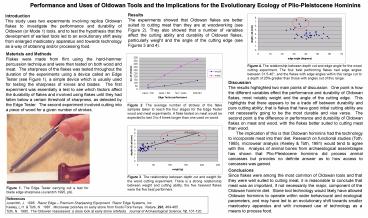Adam Newton African Genesis Poster - PowerPoint PPT Presentation
1 / 1
Title:
Adam Newton African Genesis Poster
Description:
... from flint using the hard-hammer percussion technique and were then tested on ... The sharpness of the flakes was tested throughout the duration of the ... – PowerPoint PPT presentation
Number of Views:18
Avg rating:3.0/5.0
Title: Adam Newton African Genesis Poster
1
Performance and Uses of Oldowan Tools and the
Implications for the Evolutionary Ecology of
Plio-Pleistocene Hominins
Results The experiments showed that Oldowan
flakes are better suited to cutting meat than
they are at woodworking (see Figure 2). They also
showed that a number of variables affect the
cutting ability and durability of Oldowan flakes,
particularly weight and the angle of the cutting
edge (see Figures 3 and 4).
Introduction This study uses two experiments
involving replica Oldowan flakes to investigate
the performance and durability of Oldowan (or
Mode 1) tools, and to test the hypothesis that
the development of earliest tools led to an
evolutionary shift away from enlarged masticatory
apparatus and towards technology as a way of
obtaining and/or processing food.
Materials and Methods Flakes were made from flint
using the hard-hammer percussion technique and
were then tested on both wood and meat. The
sharpness of the flakes was tested throughout the
duration of the experiments using a device called
an Edge Tester (see Figure 1), a simple device
which is usually used for testing the sharpness
of knives and blades. The first experiment was
essentially a test to see which factors affect
the durability of flakes and involved using
flakes until they had fallen below a certain
threshold of sharpness, as detected by the Edge
Tester. The second experiment involved cutting
into a piece of wood for a given number of
strokes.
Figure 4. The relationship between depth cut and
edge angle for the wood cutting experiment. The
four best performing flakes had edge angles
between 31.5-40, and the flakes with edge angles
within this range cut to a depth of 25 greater
than those with angles out of this range.
Discussion The results highlighted two main
points of discussion. One point is how the
different variables effect the performance and
durability of Oldowan flakes, most notably weight
and the angle of the cutting edge. This
highlights that there appears to be a trade off
between durability and pure cutting ability that
is flakes that have good initial cutting ability
are not necessarily going to be the most durable
and visa versa. The second point is the
difference in performance and durability of
Oldowan flakes on meat and wood, with the flakes
better suited to cutting meat than wood. The
implication of this is that Oldowan hominins had
the technology to incorporate meat into their
diet. Research on functional studies (Toth,
1985), microwear analysis (Keeley Toth, 1981)
would tend to agree with this. Analysis of
animal bones from archaeological assemblages has
shown that Plio-Pleistocene hominins did process
animal carcasses but provides no definite answer
as to how access to carcasses was gained.
Figure 2. The average number of strokes of the
flake samples taken to reach the four stages for
the Edge Tester wood and meat experiments. A
flake tested on meat would be expected to last 3
to 4 times longer than one used on wood.
Conclusions Since flakes were among the most
common of Oldowan tools and that they were well
suited to cutting meat, it is reasonable to
conclude that meat was an important, if not
necessarily the major, component of the Oldowan
hominin diet. Stone tool technology would likely
have allowed Oldowan hominins to operate within
wider behavioural and ecological parameters, and
may have led to an evolutionary shift towards
smaller masticatory apparatus and with increased
use of technology as a means to process food.
Figure 3. The relationship between depth cut and
weight for the wood cutting experiment. There is
a strong relationship between weight and cutting
ability the five heaviest flakes were the five
best performers.
Figure 1. The Edge Tester carrying out a test for
blade edge sharpness (Juranitch 1995, p9).
References Juranitch, J. 1995. Razor Edge
Premium Sharpening Equipment. Razor Edge
Systems, Inc. Keeley, L.H. Toth, N. 1981.
Microwear polishes on early stone from Koobi Fora
Kenya. Nature, 293, 464-465. Toth, N. 1985.
The Oldowan reassessed a close look at early
stone artefacts. Journal of Archaeological
Science, 12, 101-120.































